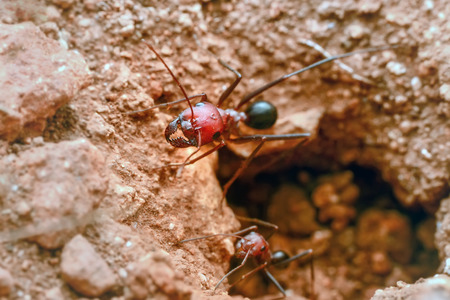Understanding Your Legal Responsibilities as a Landlord or Tenant
When it comes to preventing and removing ants, wasps, and bees from your UK property, understanding the legal responsibilities of both landlords and tenants is crucial. Under the Housing Act 2004 and various tenancy agreements, pest control duties can differ depending on the source of infestation and the terms set out in your contract. Generally, landlords are obligated to ensure that a rental property is fit for habitation at the start and throughout the tenancy, which includes being free from pest infestations that could harm health or safety. This statutory duty means that if an infestation of ants, wasps, or bees is due to structural issues or pre-existing conditions, the landlord must arrange for professional treatment. However, tenants also have contractual obligations to maintain reasonable standards of cleanliness and promptly report any signs of pests. If an infestation arises from tenant neglect—such as failing to dispose of rubbish properly or leaving food uncovered—the responsibility for resolving the issue may fall on the tenant. It is essential for both parties to carefully review their tenancy agreement, as many contracts include specific clauses detailing pest control responsibilities and reporting procedures. By being aware of these legal and contractual requirements, landlords and tenants can work together to address pest problems efficiently while avoiding disputes.
2. Recognising Signs of Infestation: Ants, Wasps, and Bees
Early identification of ant, wasp, and bee activity is crucial for effective prevention and removal within UK properties. Each species exhibits distinct behaviours and signs, which may vary according to the season. Being vigilant about these indicators can help landlords and tenants address infestations before they escalate.
Common Early Signs of Infestation
| Species | Typical Signs | Peak Activity Season |
|---|---|---|
| Ants | Trails along skirting boards, kitchen surfaces; small piles of soil or sand near entry points; sightings of winged ants indoors | Spring to late summer |
| Wasps | Papery nests in loft spaces, sheds, eaves; increased presence of wasps near windows or outdoor bins; audible buzzing from hidden spaces | Late spring to early autumn |
| Bees | Clusters of bees entering/exiting gaps in brickwork or roof tiles; honeycomb debris; persistent buzzing around chimneys or wall cavities | Spring to mid-summer (depending on species) |
Location-Specific Indicators
- Kitchens and Pantries: Ants are commonly attracted by food residues and sugary spills.
- Lofts, Sheds, Eaves: Wasps prefer secluded spots for nest-building.
- Wall Cavities and Chimneys: Bees may establish hives in quiet, undisturbed areas.
Seasonal Considerations
The likelihood and visibility of infestation signs often depend on the time of year. For example, queen wasps begin building new nests in early spring, while ant swarming typically occurs during warmer months. Bee activity may peak in late spring as colonies expand. Understanding these seasonal trends allows for timely inspections and targeted action.
Summary Table: When to Be Most Vigilant
| Month | Main Pest Risk |
|---|---|
| March – May | Queen wasps searching for nesting sites; early bee hive establishment |
| June – August | Swarms of ants; high wasp activity; expanding bee colonies |
| September – October | Mature wasp nests at their largest; final ant infestations before decline |
Regular property checks—especially during high-risk months—enable both landlords and tenants to recognise signs promptly and act in accordance with their responsibilities under UK tenancy agreements.
![]()
3. Preventative Measures for UK Properties
Preventing infestations of ants, wasps, and bees is far easier and less disruptive than removing them once theyve taken hold. UK homes and gardens often present unique challenges due to varying building ages, garden layouts, and the temperate climate. Below are practical steps and best practices specifically tailored to minimise the risk of these pests establishing themselves on your property.
Seal Entry Points
Begin by thoroughly inspecting your property for gaps, cracks, or holes around windows, doors, eaves, and utility entry points. Use appropriate sealants or weatherproof strips to block potential access routes for insects. Pay special attention to older properties where brickwork or woodwork may have deteriorated over time.
Maintain Cleanliness Indoors
Ants are particularly attracted to sugary residues and food crumbs. Regularly clean kitchen surfaces, promptly store food in sealed containers, and ensure bins are emptied frequently. Avoid leaving pet food out for extended periods and wipe down surfaces after meals.
Manage Outdoor Spaces
Wasps and bees are drawn to gardens with abundant flowers and accessible water sources. While its important not to discourage pollinators entirely, you can reduce risks by keeping bins covered, promptly clearing fallen fruit, and avoiding stagnant water in pots or birdbaths. Regularly trim hedges and lawns to minimise nesting opportunities.
Professional Property Maintenance
For landlords and tenants alike, routine maintenance plays a vital role in prevention. Schedule annual inspections of roof spaces, wall cavities, and outbuildings for early signs of nests or trails. Address any signs of dampness or decay promptly as these can attract nesting insects.
Encourage Responsible Waste Management
Ensure communal bins in flats or shared housing are managed responsibly. Overflowing rubbish provides both food sources and shelter for ants and wasps. Make use of council-provided recycling schemes to reduce build-up of waste that could attract pests.
By adopting these preventative measures as part of your propertys regular upkeep, you greatly reduce the likelihood of ant, wasp, or bee infestations becoming a costly or disruptive issue. Prevention not only protects the fabric of your home but also upholds your obligations under UK tenancy law regarding safe and habitable living conditions.
4. Protocols for Safe Removal and Reporting
Ensuring the safe and lawful removal of ants, wasps, and bees from your UK property requires adherence to both legal obligations and best practice protocols. As a landlord or tenant, it is important to understand your responsibilities under UK housing legislation, including the Housing Health and Safety Rating System (HHSRS), as well as local authority guidelines.
Legal Framework and Tenant-Landlord Duties
Under the Landlord and Tenant Act 1985, landlords are generally responsible for maintaining a safe living environment. This includes addressing infestations if they pose a health risk or affect the habitability of the property. Tenants, however, may be responsible for reporting issues promptly and taking reasonable steps to prevent infestations through good housekeeping.
When to Arrange Professional Removal
The table below provides guidance on when professional intervention is required:
| Infestation Type | DIY Action Permitted? | Professional Required? | Urgency Level |
|---|---|---|---|
| Ants (minor) | Yes | No, unless recurring/severe | Low/Moderate |
| Wasps (nest present) | No | Yes | High (risk of stings/allergies) |
| Bees (nest present) | No (protected species) | Yes (specialist beekeeper) | High (do not disturb nest) |
Reporting Procedures and Emergency Handling
If an urgent infestation occurs—such as a wasp or bee nest in a common living area—tenants should immediately inform their landlord or letting agent in writing. Landlords must respond swiftly to arrange safe removal by licensed professionals. In case of bee infestations, contact local beekeepers through the British Beekeepers Association, as bees are protected and must not be destroyed.
Documentation and Communication
Maintain written records of all communications regarding pest reports, actions taken, and contractor invoices. This ensures compliance with tenancy agreements and offers protection if disputes arise. Both parties should refer to their tenancy contract for any specific clauses related to pest control responsibilities.
5. Clauses and Terms in Tenancy Agreements Related to Pest Control
Pest control provisions are a crucial component of many UK tenancy agreements, particularly when addressing issues such as ants, wasps, and bees. These clauses typically set out the respective responsibilities of landlords and tenants regarding both prevention and removal of pests, aiming to reduce ambiguity and prevent disputes.
Common Pest Control Clauses in UK Tenancy Agreements
Most standard tenancy agreements will include explicit terms relating to pest control. Common provisions may stipulate that tenants are responsible for keeping the property clean and reporting any infestations promptly. Meanwhile, landlords are generally expected to ensure the property is pest-free at the start of the tenancy and to arrange professional treatment if an infestation arises due to structural faults or pre-existing conditions.
Breakdown of Typical Clauses
- Maintenance Obligations: Tenants must take reasonable steps to prevent infestations by maintaining cleanliness and proper waste disposal.
- Reporting Requirements: Tenants are usually required to notify landlords immediately upon discovering any signs of ants, wasps, or bees within the premises.
- Landlord’s Duties: Landlords may be obligated to arrange for professional pest control services if the infestation is not caused by tenant negligence.
- Liability for Costs: The agreement should clearly state who bears the cost for pest removal, which often depends on whether the issue is due to tenant action or a pre-existing problem.
Recommendations for Clear Drafting
For both parties’ protection, it is advisable that tenancy agreements specify in plain language what constitutes tenant versus landlord responsibility regarding pests. Clear definitions—such as what qualifies as ‘reasonable steps’ or ‘prompt notification’—help avoid subjective interpretations. Including examples relevant to common UK pests (like ants, wasps, and bees) ensures practical clarity.
Avoiding Disputes
To minimise disagreements, both landlords and tenants should review these clauses together before signing. Landlords can further support compliance by providing tenants with information sheets about local pest risks and recommended preventative measures. Should disputes arise, referencing the precise contract terms—and any supporting documentation such as inspection reports—will help facilitate swift resolution in accordance with UK law.
6. Resolving Disputes and Seeking Assistance
Disagreements between landlords and tenants regarding the responsibility for dealing with ants, wasps, or bees in a UK property can sometimes arise. It is crucial to understand your rights and options when such disputes occur. The first step should always be open communication—both parties should refer to the tenancy agreement, which may outline who is responsible for pest control in various scenarios. If an agreement cannot be reached, there are several avenues available for resolution.
Local Authorities
Should pests pose a significant health risk or render the property uninhabitable, tenants may contact their local council’s environmental health department. Local authorities have powers under the Housing Health and Safety Rating System (HHSRS) to assess hazards and, where necessary, compel landlords to take action to address infestations that impact tenants’ wellbeing.
Tenancy Deposit Scheme (TDS)
If a dispute arises over deductions from the tenancy deposit related to pest removal costs, tenants and landlords can use the free dispute resolution service provided by their chosen Tenancy Deposit Scheme. Both parties will be asked to submit evidence—such as photographs, correspondence, and invoices—and an impartial adjudicator will decide how any disputed deposit money should be allocated.
Alternative Dispute Resolution Services
If other methods fail, alternative dispute resolution (ADR) services offer a way to settle issues without resorting to court proceedings. Mediation services are available across the UK and can help both parties reach a mutually acceptable solution regarding pest management responsibilities and associated costs.
Summary of Steps
- Review the tenancy agreement for clarity on responsibilities.
- Communicate concerns promptly and document all discussions.
- Contact local authorities if there are serious health or safety risks.
- Use the TDS for deposit-related disputes.
- Consider ADR before escalating matters further.
Professional Advice
If disputes remain unresolved after pursuing these options, seeking legal advice from organisations such as Citizens Advice or a solicitor specialising in landlord and tenant law can provide further guidance tailored to your situation. Taking prompt action ensures that pest issues do not escalate into larger problems or prolonged conflicts within your rental property.


